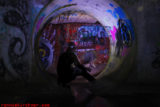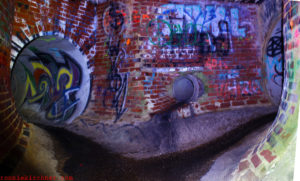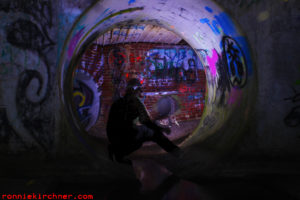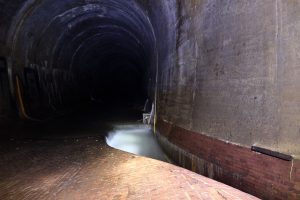
| Jenkins Run Storm Sewer Tunnel | Jenkins Run Stream | Guilford Avenue / Jones Falls Conduit Construction Tunnel|
Jenkins Run Stream is an ancient stream drains into the Jones Falls River Basin. It still exist today but pretty much has been forgotten due to it being covered over and buried in an underground culvert or tunnel. The original upper portions were constructed in the late 1870’s . Its construction spanned over a period of 30 years related to general mismanagement, lack of funds, numerous pitfalls and delays. Like many storm water drains buried in Baltimore, difficulty arouse from the varying geological conditions and numerous springs encountered. The torrential nature of this stream during periods of extreme downfall would succumb to violent flooding. Compounding these complications included poor workman ship of its contractors. Which, on a few occasions required the reworking of the drains foundation at one point. A a remarkable interceptor, with a robust history that is not even touched in this writing.
The Jenkins Run Storm sewer, intercepts and drains a moderate portion of the North Eastern drainage basin of Baltimore City. Most notably the Carter Alley stream (which had already been buried for some time) was junctioned into the tunnel via the Old Carter Alley Sewer. The At one point it crosses under the Union Railroad tunnel and in turn serves as a drainage point via a 33cm (13 inch) cast iron pipe(ref.). Its tunnel network traverses through a portion of Greenmount Cemetery. At one point the tunnel even crosses near a section of old graves. It is quite well preserved and shows little signs of wear. Tunnel sections vary significantly throughout including: height, width, design and material composition.
The “newer” lower interceptor tunnel was finished in 1912, with the completion of the JF conduits and the Guildford Avenue Diversion tunnel. Chief Engineer Calvin Hendrickson awarded the work contract to the “Fisher Brother Company”. Hendrickson reported to the Baltimore Sun during a walk through tour that this final portion of the tunnel was bored through solid rock to the size of 365cm (12ft). At its deepest point the tunnel lies 16 meters deep (52 feet). Its construction team were described as looking like “miners”. The most modern 20th century methods were used to in its boring . Costly modern machinery that ran off compressed air were used and the workers had the luxury of electrical power to light their work area. Power being provided by a generation plant off Preston street. (ref.c)
It should be noted that before its completion, the lower portion of the Jenkins Run Interceptor drain was used as a haulage construction tunnel. Materials were hauled in and out of the tunnel. Much of the excavated rock was processed and used in the concrete mixtures in the tunnels found downstream. At its completion, the loathsome CSO / SSO #72 was placed. It boasts a significant steep grades, staircase / drop falls, full brick tunnels, brick arch horseshoe tunnels, masonry granite, overhead flume, long curves, numerous stone granite side drains and a CSO/SSO purge discharge point. In the upper mid section of the tunnel, houses a sizable double junction chamber. The western tunnel is old granite stone construction drain, that doesn’t work well. Standing water and old air back in there . The eastern shaft is the continuation of Jenkins Run. Basically, the further you go back, the older is gets. And the Jenkins Side goes back deep, well above North Ave and with its limited surface access presents the most fearsome environment in an already dangerous city.
Historical Quotations:
“The Jenkins Run Drain empties into the Jones Falls between Preston and Hoffman streets runs northerly via Carter alley to a point 135 feet north of Lafayette avenue and thence northeasterly to a point in Boone street north of Twentieth street For 3,270 feet to a point in Walcott street it has cross sections of from 163 to 49 square feet and is built with a segmental arch Above this it is circular and 10 feet 6 inches in diameter It drains nearly 900 acres including Homestead and that part of Waverly east of the York Road It has two principal branches
- In Hoffman street to Home wood avenue 4 feet in diameter
- In Girard avenue to Barclay street 3 feet in diameter .”
(ref. 1)
“The heading of the tunnel under Guilford avenue has been extended from the entrance of the retaining wall between Biddle and Chase streets to a point 250 feet beyond Preston street a total distance of 8oo feet The heading of the Jenkins Run Sewer tunnel has been extended through to meet the large tunnel a distance of 430 feet The rock excavated from this tunnel is being crushed and used to form the concrete conduits in the bed of the Falls below Chase street.”
(ref. 2)
TUNNEL EXPLORATION NOTES:
Exploring a massive 12 foot drain, from within another massive drain requires knowledge, planning, physical fitness and wit. Such a treacherous adventure should not be carried out by a casual urban explorer, the ill prepared or weak hands. When this drain was discovered, research seemed to point that this tunnel was draining what was once known as “Jenkins Run”. An ancient stream that was buried & covered over well over a century ago and is the largest buried stream outfall in the Jones Falls Conduit system. Every time this tunnel was passed, a strong curiosity beckoned for its penetration. What lies inside was an unknown, granted its overall large size, one could only assume it was the beginning of a large storm sewer network. If subsequent research was on point, it seemed that sizable chambers may lay within. Years later, infiltration was undertaken and the curiosity laced with patience & preparation paid off. A strong wind pours out of this tunnel, however, it was decided that subsequent exploration would require a Multi-Gas Detector.
The Buried Outfalls Entrance into the system

The tunnel briefly bears right before straitening out, most likely for hydrological considerations as it meets the underground Jones Falls river

Jenkins run and Carter Alley Junction Chamber

Looking up the stairway towards the later portion of it.

The original Jenkins Run diversion chamber photo source (ref .2)

A quick video glimpse of Jenkins Run Outfall
references:
a)Report of the Sewerage commission of the city of Baltimore , 1897
b)Baltimore Sewerage Commission Annual Report, 1913
c) THROUGH CITY’S TUNNEL: MAYOR AND OTHER OFFICIALS HAVE WALK UNDER, Baltimore Sun. , Dec 11, 1912








 There is a certain psychology or piece of the human experience that correlates with the idea of pushing forward to “the Light at the end of the tunnel“. Let me explain, this is the proverbial idiomatic light, where in your working towards a goal, and the goal is near. Or the actual rays of sunlight, seen during the evacuation stage of
There is a certain psychology or piece of the human experience that correlates with the idea of pushing forward to “the Light at the end of the tunnel“. Let me explain, this is the proverbial idiomatic light, where in your working towards a goal, and the goal is near. Or the actual rays of sunlight, seen during the evacuation stage of 






